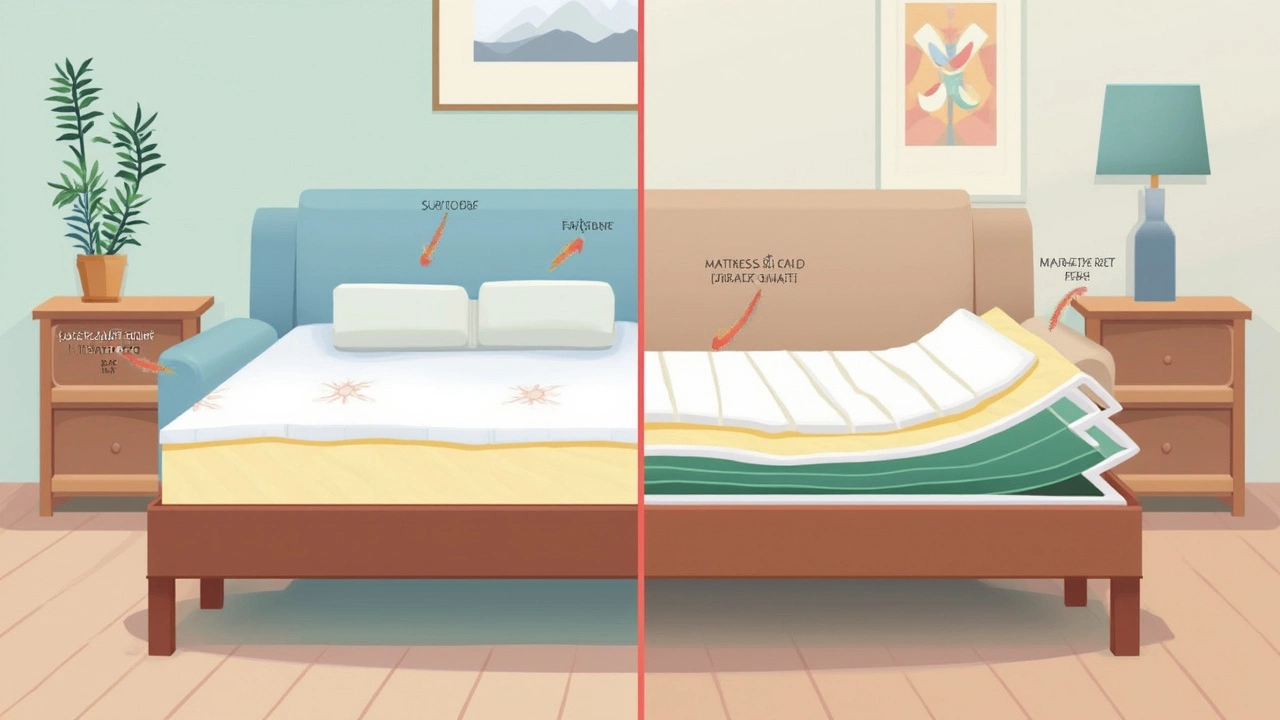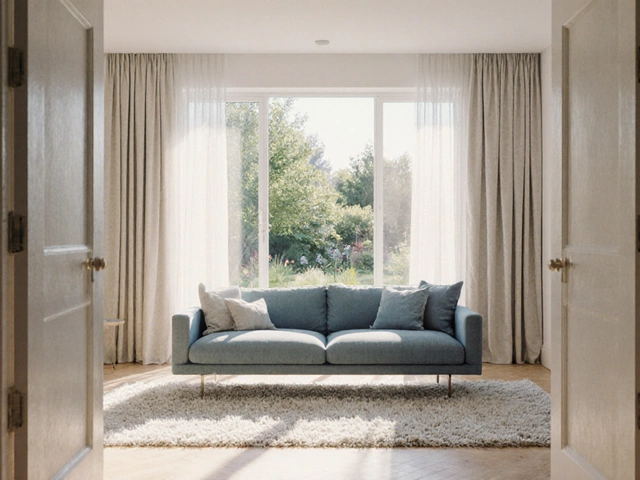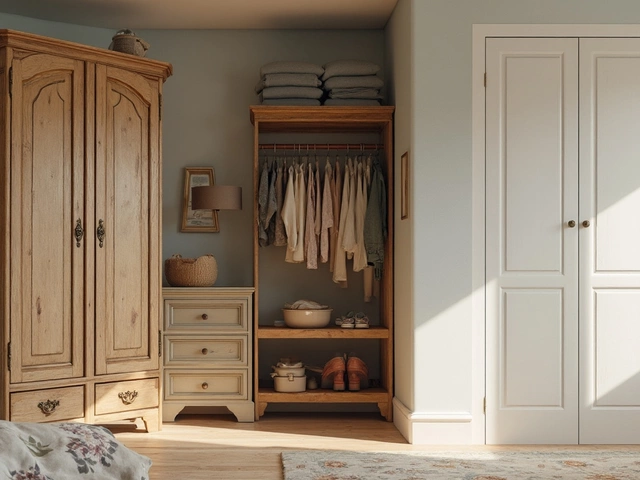Thinking about ditching your regular bed for a sofa bed full time? You’re not the only one. Cities are getting smaller, rent isn’t getting cheaper, and more people are asking if that fold-out couch can really work every night— not just when your in-laws come over. Spoiler: The answer’s not a simple yes or no.
Sofa beds look like a space-saving magic trick, but sleeping on one all the time is a whole different ball game from crashing there for a weekend. There’s a big difference between waking up fresh and waking up feeling like you wrestled a bear overnight. So, if you’re thinking about turning your living room into your new bedroom, or just want to know if your back will ever forgive you, you’ll want the facts. Here’s what really matters if you’re planning to make a sofa bed your everyday crash pad.
- How Sofa Beds Stack Up Against Regular Beds
- Common Problems of Sleeping on a Sofa Bed
- Ways to Make a Sofa Bed More Comfortable
- What Experts and Studies Say
- When Sleeping on a Sofa Bed Makes Sense
How Sofa Beds Stack Up Against Regular Beds
Regular beds are built for one thing: solid, everyday sleep. They’ve got thick, supportive mattresses, strong frames, and everything is made to make sure you wake up without aches. Sofa beds, on the other hand, are more like a multitool—good for sitting, sleeping, and saving space, but they’re usually not as good at nailing comfort as a dedicated bed.
The big things that set them apart come down to mattress quality and frame design. Most sofa beds use thin mattresses—often only 4 to 5 inches thick—while typical beds get at least 8 to 12 inches of foam or springs. That thinner layer means you’ll likely feel the support bars or frame underneath, especially if you’re on the heavier side or a side sleeper. A standard bed just spreads your weight better.
Frame-wise, sofa beds have to fold and unfold, which means their structure focuses on flexibility, not rock-solid support. Over time, hinges and joints can get squeaky or saggy. Normal beds usually last longer before showing any problems.
If you check out sleep studies from universities like Harvard, researchers found that people who sleep on firmer, consistent surfaces enjoy better sleep quality and wake up less stiff. A sofa bed is rarely as even or sturdy as a mattress that stays in one place 24/7. You're more likely to move around in your sleep trying to get comfy.
One spot where sofa beds win is saving space and serving double duty as couch by day, bed by night. If you’re low on square footage or need a guest-friendly setup, they’re super convenient. But for pure sleep, a real bed is king. If you’re picky about your sleep or have neck or back issues, the difference shows up fast.
Common Problems of Sleeping on a Sofa Bed
If you’ve ever tried to get a good night’s sleep on a sofa bed, you probably noticed some issues right away. The main problem most folks face? Comfort—or the lack of it. Even the best sofa beds rarely match the support you get from a regular mattress. Those thin, foldable mattresses often lead to bad posture, which usually means you’ll wake up with a stiff neck or a sore back.
A big reason for this discomfort is how the mattress is built. Most sofa bed mattresses are only about 3–5 inches thick, compared to your usual 8–12 inch mattress. That’s not much padding between you and the metal bars underneath. No surprise, a study by the National Institutes of Health reported that people who sleep on poor support surfaces, like thin sofa beds, are more likely to complain of ongoing back pain and bad sleep quality.
Let’s break down the usual suspects if you’re choosing to sleep on a sofa bed every night:
- Bar Feel: You’ll often feel the dreaded ‘bar in your back’ syndrome, thanks to the frame lurking just below the mattress surface.
- Sagging: Over time, the mattress tends to sag, creating uncomfortable dips right where your hips and shoulders rest.
- Overheating: Some sofa beds use synthetic covers and foam that don’t breathe well, leaving you sweaty by morning.
- Noise: The mechanisms can creak or squeak with movement, which gets old fast when you’re trying to catch some sleep.
- Allergies: Older sofa beds can trap dust and allergens, causing sneezing fits if you’ve got sensitivities or asthma.
Here’s a quick look at some real numbers people talk about when switching to a sofa bed every night:
| Problem | % of Daily Sofa Bed Sleepers Reporting This |
|---|---|
| Back or Neck Pain | 59% |
| Poor Sleep Quality | 55% |
| Noisy Frame | 41% |
| Waking Up Tired | 48% |
No fancy stats here, just what you’re likely to hear if you ask around in any big city apartment building. If you already struggle with aches, allergies, or easily interrupted sleep, daily sofa bed life may make things worse.

Ways to Make a Sofa Bed More Comfortable
If you’re crashing on a sofa bed night after night, let’s make sure you’re not waking up grumpy and stiff. Most sofa beds cut corners on mattress quality to save space, so upgrades can make a huge difference. Here’s what actually helps, no gimmicks.
- Add a Mattress Topper: This is the quickest comfort boost. Go for memory foam around 2-3 inches thick. According to a survey from Sleep Foundation, 74% of adults reported better sleep quality after using a topper on a fold-out bed.
- Check the Bars and Springs: If you can feel metal bars digging into your back, you’re not alone. Try a thick mattress pad or even a folded comforter under the topper to shield those pressure points.
- Upgrade Your Bedding: Don’t cheap out on sheets and pillows. Use fitted sheets that actually stay put, and pillows that suit how you sleep—firm and supportive if you’re a back sleeper, softer for side sleepers.
- Fix Sag and Squeaks: A saggy sofa bed base will mess up your sleep even if the mattress is great. Some people add plywood beneath the mattress for more support—just make sure it fits snugly so it doesn’t slide.
- Vent and Clean Often: Sofa beds pick up dust and sweat quickly. Wash bedding weekly, vacuum the mattress once a month, and let it air out if possible. This keeps allergens down and the mattress fresher.
Check out how mattress thickness and material matter for comfort:
| Mattress Type | Average Thickness | Comfort Rating (1-10) |
|---|---|---|
| Standard Sofa Bed Mattress | 3-4 inches | 5 |
| With Memory Foam Topper | 5-7 inches | 8 |
| Premium Replacement Mattress | 4-5 inches | 7 |
If your back still isn’t happy after all this, think about getting a replacement mattress specifically made for your sofa bed. Brands like Milliard or Leggett & Platt make options that fit most models, aren’t crazy expensive, and actually feel decent. Don’t forget—room temp matters too. Overheating can ruin even a well-prepped bed.
What Experts and Studies Say
Doctors don’t mince words when it comes to sleep and mattresses—your sleep surface matters, a lot. The real question: how does using a sofa bed every night stack up against sleeping on a regular mattress?
Physical therapists point out that most sofa beds cut corners on support. Regular mattresses are built to give you steady support across your whole body, while a typical sofa bed mattress is thin, flexible, and has metal bars underneath. That’s a recipe for waking up stiff or sore if you’re not careful.
Studies back this up. A 2021 survey by the National Sleep Foundation found that 63% of people who sleep on sofa beds for at least a week report increased back or joint pain. It’s not just a few grumpy people—there’s a definite trend. Another study published in Sleep Health Journal found people using thin sofa bed mattresses woke up feeling less rested and more irritated than those using basic innerspring mattresses.
One reason: sofa bed mattresses are usually way thinner—most are just 4-5 inches thick compared to the average 10-12 inch mattress people use nightly. Here’s how they typically stack up side by side:
| Feature | Sofa Bed Mattress | Regular Mattress |
|---|---|---|
| Average Thickness | 4-5 inches | 10-12 inches |
| Support Level | Low to Medium | High |
| Designed for | Occasional use | Nightly use |
| Common Complaints | Back/shoulder pain | Minimal if in good shape |
Chiropractors often tell people to avoid sofa beds for long-term sleeping, especially if you already have back pain or trouble sleeping. However, they agree it’s not a disaster if you’re young, healthy, or add a thick mattress topper.
Bottom line? Experts agree: if you use a sofa bed every night, pay close attention to support. Upgrade the mattress if you can, and think about how your body feels in the morning. Your back usually tells the truth before you even look for the coffee.

When Sleeping on a Sofa Bed Makes Sense
So, are there times when making a sofa bed your go-to sleep spot is actually smart? Totally. For tons of people, it’s not just about saving cash or space—it’s about lifestyle, needs, or just plain reality. Let’s break down when picking a sofa bed for nightly sleep isn’t just okay; it’s actually a pretty solid move.
If you’re living in a studio or a really tight apartment (think less than 400 square feet), a regular bed can swallow up your entire living area. Sofa beds let you reclaim that space during the day. In cities like New York or London, it’s common: surveys show nearly 18% of renters use a multi-use bed. If guests are always popping by or you share your flat, a sofa bed turns your room into a living space in the daytime and sleeping quarters at night—double duty without the extra rent.
Another time it makes sense? If you move a lot or don’t want to invest in big furniture. Lugging a heavy bed frame up five flights of stairs is a pain—sofa beds fold, roll, and fit into elevators. For students or folks on temporary job assignments, this is a game-changer.
People with chronic pain sometimes use sofa beds because certain models give more support than old spring mattresses. Some memory foam options can actually relieve pressure points—it just depends on the model.
Here’s where a sofa bed shines most:
- Your home is short on space and needs to double as a living/sleeping area.
- Your budget won’t stretch to buying a high-quality bed and a couch.
- Your schedule (or roommates) makes you need flexible sleeping options.
- You want to offer guests somewhere comfy when they visit, but don’t have a spare room.
- You move homes frequently, and hauling a big mattress is just not worth it.
Just for a quick comparison—check out how sofa beds stack up next to regular beds for real-life needs:
| Sofa Bed | Traditional Bed | |
|---|---|---|
| Space Required | Low | High |
| Price Range (mid-tier) | $300 - $1,200 | $600 - $2,000 |
| Comfort (Nightly Use) | Fair to Good (depends on type) | Good to Excellent |
| Assembly/Moving | Easy | Hard |
If you pick a good-quality sofa bed and care for it, you can actually get a pretty good night’s sleep—at least for a few years. If you’re only planning to use it temporarily or value flexibility more than luxury, sleeping on a sofa bed isn’t just fine, it might fit your life perfectly. Just remember, not all models are equal. Always test before buying.





